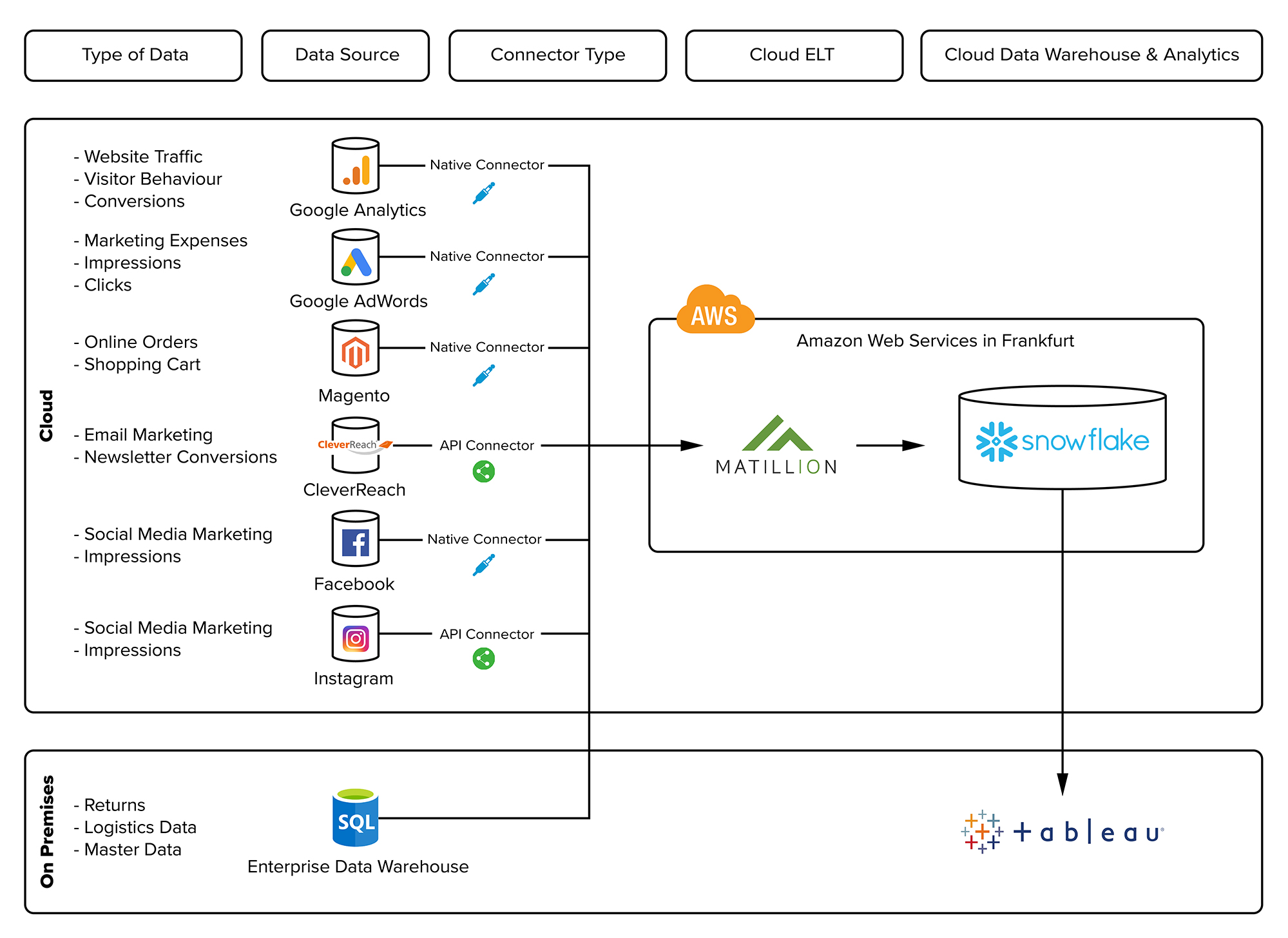
Börlind is a leading natural cosmetics manufacturer based in the Black Forest of Germany.
Technologies Used:
Services Used:
As a leading natural cosmetics manufacturer based in the Black Forest of Germany, Börlind has grown continuously since the 1970s to become a global brand. Börlind’s products can be found on the most exclusive shopping streets in the world. With products ranging from skincare over make-up to hair products, Börlind and their two brands, “Annemarie Börlind Natural Beauty” and “DADO SENS Dermacosmetics,” use solely natural raw materials for their award-winning products.
So Many Data Sources!
As one of the most established firms in natural cosmetics, Börlind’s products can not only be found in retail stores across the world but also on their beautifully designed website. Being active in the e-commerce business requires timely, data-driven decisions. This necessitates up-to-date, valid data from various sources, which must be presented in a way that can be easily compared and contextualized.
Decision-makers at Börlind are thus faced with a myriad of numbers and KPIs from sources like Google Ads, Google Analytics, Facebook, Instagram, YouTube, Twitter, e-commerce platforms, email marketing platforms, and on-premises ERP and CRM systems. Google, Facebook and e-commerce platforms already offer dashboards and real-time insights within their own services, but this only gives the marketer a fraction of the whole picture. Calculating metrics like the return on marketing investments (ROI) or conversion rates across platforms can be very cumbersome for a company like Börlind using traditional means. Additionally, they need to access these insights quickly in order to make timely decisions in a rapidly moving market. Meanwhile, programming flows to retrieve data from these services is cost and time-intensive.

Tableau to the Rescue
As a data-driven organisation, Börlind has already implemented Tableau and thus has the means to analyse data from various sources using Tableau’s built-in connectors. While these connectors are great for retrieving data from each source individually, in order to make sense of the data and discover overall patterns, data from various sources had to be brought together in one place with a coherent structure. These intermediary steps of data pre-processing and data integration were needed due to several constraints that come with connecting to these data sources right from Tableau:
- Google has strict rules on how many rows and columns can be pulled from its API in a single query – answering complex questions with that can be difficult.
- While their e-commerce platform, Magento, is based on a MySQL database, this database is not built for the heavy load that comes from Tableau queries.
- Some data living in web data sources can only be retrieved using complex API queries, which meant that some kind of connector (e.g. a Tableau web data connector) would need to be programmed. This implied the need for upskilling someone to write the code necessary and maintain any future efforts.
The Need for a Scalable and Manageable Solution
Matillion was the solution of choice for staging, pre-processing, and loading data into Snowflake, the chosen cloud data warehousing solution. The reasons for this choice are manifold: Both Matillion and Snowflake are very easy and quick to set up. A Matillion instance is created by signing up for an Amazon Web Services (AWS) account and starting the EC2 instance. The initial setup for Snowflake encompasses signing up for an account and logging in – that’s it! With this quick and easy setup, there was nothing in the way of starting to use the tools, which was supported both by readily available online learning resources as well as excellent customer support from Snowflake and Matillion. Hence, new users will be able to tap into this new area of analytics easily as there is plenty of support.
New Architecture Benefits
- Pay-as-you-go model is cost-effective
- Scalability, security and speed
- Native connector to Tableau
- Ability to answer deeper questions
Furthermore, in the case at hand, it made sense to first learn the new tools and then identify the users’ needs along the way. An added benefit is that once this solution is scaled, it shouldn’t incur a huge upfront investment for hardware and software. Therefore, the advantages of the cloud could fully be harnessed. In respect to Börlind’s bottom line, the pay-as-you-go models of both Matillion and Snowflake didn’t tie up capital and resources unnecessarily. A big advantage of Snowflake is that, while it is highly scalable, secure and incredibly fast, you can connect to it with Tableau’s native Snowflake connector like any other relational database, making use of all of Tableau’s functions and possibilities. My colleague, Holt Calder, explains why Tableau and Snowflake are such a great match in this informative blog post.
Lastly, we could leverage the information that Snowflake makes readily available about how it is used and create transparency around how much Börlind’s online analytics cost. These costs could be monitored on a high level, answering questions like, “how much are we paying for extracting and loading data?” down to the query level of “how much does it cost us to analyse ad performance on Google?” This level of cost transparency is hard, if not impossible, to achieve with an on-premises database solution. For those who are curious, Tableau released this ready-made dashboard to monitor your Snowflake usage and costs.
The Path to Continued Analytic Success
Having a deep and long-term relationship with Tableau, Snowflake and Matillion, InterWorks was well-positioned to help Börlind build a successful online analytics platform. In an initial proof of concept, data was moved from all specified sources into Snowflake to test the feasibility of Matillion as an extract and load tool. Leveraging Matillion’s easy-to-use API profile system, integrations that are not natively supported by Matillion, such as Cleverreach, could easily be set up.
Data Stack Breakdown
- Matillion used for ETL and transformations
- Snowflake used for data warehousing in the cloud
- AWS used for Snowflake and Matillion instances
- Tableau used for analysis
Once all connections to source data had been established, a target data model was defined and created in Snowflake. Lastly, any data transformations that needed to be done to the data in Snowflake were set up in Matillion. All jobs were scheduled using the job scheduler in Matillion and CloudWatch to start up and shut down the Matillion instance. Another colleague of mine, Benjamin Du, shares how easy it is to load data into Snowflake using Matillion in this blog.
The biggest advantage for Börlind now that their new data warehousing solution is in place is that the data now securely available in Snowflake can be easily accessed by Tableau users from Tableau Desktop and Tableau Server. With rapid insights readily available, they can steer their online analytics practice to answer business questions with great speed and confidence.

